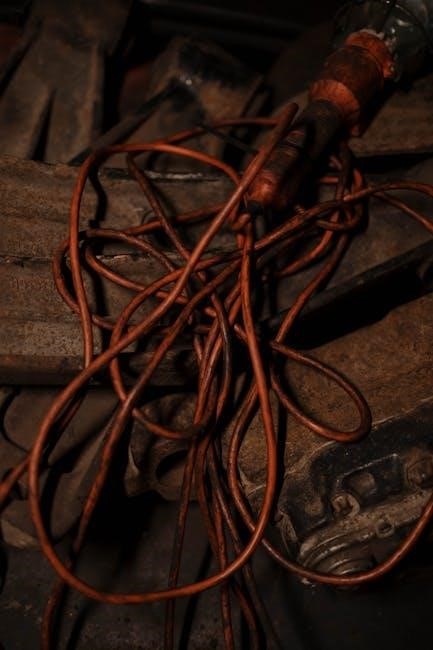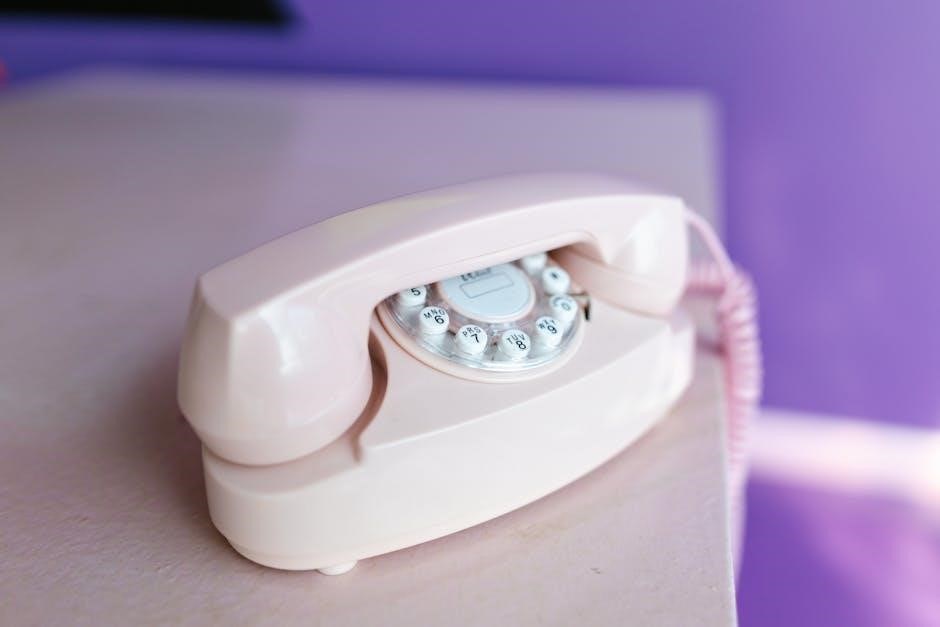
extension cord gauge guide
An extension cord gauge guide helps users understand the importance of wire thickness and its impact on safety, power delivery, and efficiency for various applications and devices.
Understanding the Importance of Wire Gauge in Extension Cords
The wire gauge in extension cords determines the maximum current it can safely conduct. A lower gauge number indicates a thicker wire, capable of handling higher currents, essential for power-hungry devices like heaters or tools;
Overview of AWG (American Wire Gauge) Rating System
The American Wire Gauge (AWG) system measures wire thickness, with lower numbers indicating thicker wires capable of carrying more current. Common gauges for extension cords range from 10 to 20 AWG. This standardized system helps users match the right cord to their power needs, ensuring safety and efficiency in various applications.
Factors Affecting Extension Cord Gauge Selection
Selecting the right extension cord gauge is crucial for safety and efficiency. Factors include power requirements, cord length, environmental conditions, and conductor material.
Power Requirements of Connected Devices
Power requirements of connected devices directly influence the extension cord gauge selection. Higher power devices demand thicker gauges to safely handle increased current. Always calculate the total power draw and match it to the cord’s capacity to avoid overheating or electrical hazards. Underestimating power needs can lead to unsafe conditions. Choose a gauge that exceeds the required current for reliable operation.
Length of the Extension Cord and Voltage Drop
The length of the extension cord significantly impacts voltage drop, which is the loss of voltage over distance. Longer cords increase resistance, leading to greater voltage drop. A thicker gauge is required to minimize this effect. Using the correct gauge ensures safe and efficient power delivery, especially for high-power devices over extended distances.
Environmental Conditions and Usage Scenarios
Environmental conditions like temperature, humidity, and exposure to weather impact extension cord performance. Indoor cords differ from outdoor ones in durability and insulation. Usage scenarios, such as powering tools or appliances, determine the necessary gauge and flexibility. Harsh environments may require heavier-duty cords to ensure safety and reliability under varying conditions.
Conductor Material and Flexibility Needs
The choice of conductor material, such as copper or aluminum, affects the extension cord’s performance and durability. Copper is more conductive but costs more, while aluminum is lighter yet less efficient. Flexibility needs vary: stranded wires are better for frequent bending, while solid-core wires suit stationary uses, ensuring reliability in different applications.
Safety Considerations for Extension Cord Usage
Ensure cords meet maximum current capacity to prevent overheating and fires. Always check for voltage drop and avoid overloading to maintain safe operating conditions and durability.
Maximum Current Capacity and Safe Operating Limits
Understanding the maximum current capacity of an extension cord is crucial for safe usage. Exceeding the rated current can cause overheating, damage, or fire hazards. Always ensure the cord’s AWG rating matches the power requirements of connected devices to maintain safe operating limits and prevent potential electrical risks or malfunctions. Check specifications carefully.
Understanding Voltage Drop and Its Impact
Voltage drop occurs when electricity travels through an extension cord, causing energy loss. Thicker wires (lower AWG) reduce this loss, ensuring devices receive adequate power. Excessive voltage drop can lead to inefficient performance, overheating, or damage. Choosing the correct gauge for the cord’s length and load ensures safe, efficient energy delivery to connected devices.
Temperature Ratings and Overheating Risks
Extension cords have temperature ratings to prevent overheating, a common risk when using incorrect gauges. Overheating occurs due to excessive current or inadequate wire thickness, potentially causing fires. Always choose cords with appropriate temperature ratings for your environment and usage demands to ensure safe, reliable operation and avoid thermal damage to the cord or connected devices.
Matching Extension Cord Gauge to Specific Devices
Choosing the right extension cord gauge ensures safe and efficient power delivery. High-power appliances require lower gauges (10-12 AWG), while smaller devices use higher gauges (16-18 AWG).
Appliances with High Power Consumption
High-power appliances, such as refrigerators or air conditioners, require extension cords with lower AWG ratings (10-12) to handle higher current demands safely. Using the correct gauge prevents overheating, ensuring reliable and efficient power delivery. Incorrect gauges can lead to voltage drop or fire hazards, making proper selection critical for heavy-duty applications.
Low-Power Devices and Their Requirements
Low-power devices, such as lamps, smartphones, and small electronics, typically require extension cords with higher AWG ratings (18-20). These gauges ensure safe and efficient power delivery without excess current capacity. Using the correct gauge prevents overheating and maintains optimal performance for lightweight, everyday applications, ensuring reliability and longevity for indoor use. Proper selection is essential for safety and efficiency.
Tools and Equipment for Heavy-Duty Applications
Heavy-duty tools and equipment, such as power tools, construction machinery, and industrial devices, require extension cords with lower AWG ratings (10-12) to handle higher current demands. These thicker gauges ensure reliable power delivery over longer distances without significant voltage drop, making them ideal for demanding environments where consistent performance and safety are critical. Always match the cord to the device’s power requirements for optimal efficiency and safety.

Extension Cord Length and Gauge Relationship
Longer extension cords require thicker wire gauges to minimize voltage drop and ensure safe power delivery. Thicker wires (lower AWG) handle higher current over greater distances effectively.
How Longer Cords Require Thicker Wire Gauges
Longer extension cords experience greater voltage drop due to increased resistance in thinner wires. Thicker wires (lower AWG) reduce resistance, ensuring safer current flow and maintaining voltage levels. For longer cords, using a lower AWG is essential to handle higher power demands efficiently and prevent overheating or performance issues.
Calculating the Minimum Gauge for Desired Length
To determine the minimum gauge for your extension cord, consider voltage drop, power requirements, and length. Use the formula V = I imes R to calculate resistance. Higher resistance in longer cords demands thicker wires. Refer to an AWG chart to select the appropriate gauge that ensures safe current flow and minimal voltage drop for your specific application.
Types of Extension Cords and Their Typical Gauges
Extension cords vary by gauge, with lighter-duty options for indoor use and heavier gauges for outdoor or high-power applications, ensuring safe and efficient power delivery across different scenarios.
Light-Duty Extension Cords (18-20 AWG)
Light-duty extension cords with 18-20 AWG ratings are suitable for low-power devices like lamps, small electronics, and indoor appliances. They are portable, flexible, and ideal for light household use but not recommended for high-current applications or outdoor environments due to their thinner wire thickness and lower current-carrying capacity.
Medium-Duty Extension Cords (14-16 AWG)
Medium-duty extension cords with 14-16 AWG ratings are designed for moderate power needs, such as small appliances, power tools, and outdoor equipment. They offer a balance between durability and flexibility, making them suitable for both indoor and light outdoor use, while handling higher currents than light-duty cords but not extreme heavy-duty applications.
Heavy-Duty Extension Cords (10-12 AWG)
Heavy-duty extension cords with 10-12 AWG ratings are designed for high-power applications, such as large machinery, construction equipment, and heavy tools. These cords are built with thicker wires, offering superior durability and resistance to damage. They are ideal for outdoor or industrial use, ensuring reliable performance in demanding conditions while maintaining safety and efficiency.

Tips for Installing and Using Extension Cords Safely
Always secure connections firmly to prevent arcing, avoid overloading cords with multiple plugs, and follow outdoor vs. indoor usage guidelines to ensure safe and reliable operation.
Secure Connections to Prevent Arcing
Ensure all connections are tightly plugged in to prevent arcing, which can cause fires or damage. Regularly inspect cords for loose or damaged plugs, and avoid overloading outlets. Always use high-quality extension cords with secure-fitting connectors to maintain safe and reliable electrical connections, reducing the risk of arcing and potential hazards;
Avoiding Overloading and Multiple Plugs
Avoid overloading extension cords by adhering to their power ratings. Never use multiple plugs or adapters to connect multiple high-power devices, as this can exceed the cord’s capacity. Always opt for high-quality cords with appropriate AWG ratings to prevent overheating and ensure safe operation, reducing the risk of electrical hazards and potential fires.
Outdoor vs. Indoor Usage Guidelines
Always use extension cords rated for their intended environment. Outdoor cords are designed to withstand weather and moisture, ensuring safe operation in harsh conditions. Indoor cords prioritize flexibility and convenience but may not be durable outdoors. Using the wrong type can lead to electrical hazards, so choose cords certified for their specific use case to maintain safety and efficiency.
Troubleshooting Common Issues with Extension Cords
Identify and resolve issues like overheating, voltage drop, or damaged cords. Check for overloaded circuits, worn insulation, or excessive cord length, which can cause inefficiency or safety hazards.
Overheating and Its Causes
Overheating in extension cords is often caused by using a gauge too small for the current, overloading, or excessive cord length. This can lead to unsafe operating temperatures. Always choose a cord with the appropriate AWG rating for your device’s power needs. Using cords with high-quality, durable materials like copper can help reduce overheating risks. Avoid overloading cords with multiple high-power devices to ensure safe and efficient operation.
Voltage Drop Symptoms and Solutions
Voltage drop occurs when an extension cord’s gauge is too small for the current, causing devices to underperform or lights to dim. Symptoms include reduced power output and inefficient operation. Solutions include using a cord with a lower AWG rating or shorter length. Ensure the cord is suitable for the device’s power requirements to minimize voltage drop effectively.
Diagnosing Faulty or Damaged Cords
Check for visible damage like frayed wires, burn marks, or cracked insulation. Test for continuity using a multimeter to ensure proper connections. Look for intermittent performance or reduced power output, which may indicate internal damage. Regular inspections can help identify faults early, preventing safety hazards and ensuring reliable operation of connected devices.

Best Practices for Choosing the Right Extension Cord
Always check product specifications for gauge, length, and power ratings. Consult manufacturer guidelines to ensure compatibility with your devices. Regularly test and inspect cords for damage to maintain safety and efficiency.
Read Product Specifications Carefully
When selecting an extension cord, carefully review product specifications to ensure it meets your needs. Look for details like gauge rating, maximum voltage, and power capacity. Check the length and flexibility of the cord to suit your application. Ensure the cord is rated for indoor or outdoor use and made from durable materials. Always match the specs to your device’s requirements for safe and efficient operation.
Consult Manufacturer Guidelines
Always consult the manufacturer’s guidelines for extension cords to ensure safe and proper use. Check the recommended gauge ratings, power capacity, and environmental ratings. Adhere to their advice on maximum load and operating conditions to prevent overheating or electrical hazards. Following these guidelines helps maintain safety and ensures efficient performance for your specific needs.
Testing and Inspecting Cords Regularly
Regular testing and inspection of extension cords are crucial for safety. Check for frayed wires, damaged plugs, or signs of overheating. Use a multimeter to test continuity and ensure the cord’s gauge matches its intended use. Replace any damaged cords immediately to prevent electrical hazards and maintain reliable performance. Always prioritize safety and adhere to standards for optimal functionality.

Future Trends in Extension Cord Technology
Innovative solutions are emerging, such as smart cords with built-in monitoring, high-tech materials for improved safety, and seamless integration with smart home systems for enhanced efficiency and convenience.
Smart Extension Cords with Built-In Monitoring
Smart extension cords now feature real-time monitoring of power usage, voltage, and temperature. These cords can detect overloads, prevent overheating, and integrate with smart home systems for remote control and energy tracking, enhancing safety and efficiency through advanced technology and connectivity.
High-Tech Materials for Improved Safety
Advanced materials like flame-retardant coatings and high-temperature-resistant polymers enhance extension cord safety. These innovations reduce fire risks, improve durability, and ensure reliable performance in extreme conditions, making them ideal for both indoor and outdoor applications while maintaining efficiency and longevity. This ensures safer and more dependable power delivery across various environments and usage scenarios.
Integration with Smart Home Systems
Smart extension cords integrate seamlessly with smart home systems, offering remote monitoring and voice control. These cords provide real-time energy usage data, overheat protection, and automatic shutdown features. Ensuring enhanced safety and efficiency, they adapt to various devices, making smart homes smarter. This integration simplifies power management and elevates convenience for users. Modern innovations continue to expand their capabilities.
Frequently Asked Questions (FAQs)
This section addresses common queries about extension cord gauges, such as using the wrong gauge, indoor vs. outdoor use, and proper storage, ensuring safety and efficiency for users.
What Happens If I Use the Wrong Gauge?
Using the wrong gauge can lead to overheating, voltage drop, and fire hazards. It may also damage connected devices or reduce efficiency. Always match the cord’s gauge to the device’s power requirements to ensure safety and optimal performance.
Can I Use an Indoor Cord Outdoors?
Using an indoor cord outdoors is generally not recommended, as it may not be designed to withstand weather conditions, moisture, or temperature fluctuations. This can lead to safety hazards, including electrical shock or fire. Always opt for cords rated for outdoor use to ensure reliability and safety in external environments.
How Do I Store My Extension Cord Properly?
Store extension cords in a cool, dry place, away from direct sunlight and moisture; Avoid tight coils to prevent kinks and damage. Use a storage reel or hang them to keep them organized and tangle-free. Inspect cords for damage before storing and ensure they are completely dry to maintain safety and longevity.
Understanding extension cord gauges ensures safe and efficient power delivery. Always choose the right gauge for your needs to avoid hazards and optimize performance.
Summarizing Key Takeaways for Safe and Efficient Use
Choosing the right extension cord gauge ensures safe and efficient power delivery. Match the cord’s AWG rating to your device’s power needs, consider length and voltage drop, and avoid overloading. Always follow safety guidelines to prevent overheating and electrical hazards, ensuring reliable performance for all applications.
Encouraging Readers to Apply the Guide in Real-World Scenarios
By understanding extension cord gauges, readers can make informed decisions for safe and efficient power delivery in homes, workshops, or outdoor settings. Encourage applying these guidelines to prevent hazards and ensure optimal performance for devices, fostering a culture of electrical safety and practical problem-solving in everyday scenarios.

